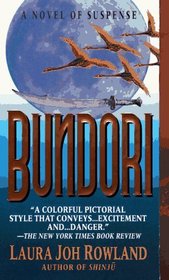Helpful Score: 4
This is Rowland's 2nd book published in 1996. She is now in 2006 coming out with her 11th title. These earlier books which I prefer - Shinju (1994), Bundori, The Concubine's Tattoo(1998), The Samarai's Wife(2000) - set the tone for the rest.
Laura Joh Rowland's Web site introduces book and term Bundori as follows, "In the misty streets and alleys of Edo, Japan's feudal capital, a serial killer lurks. Each victim is rendered up as a severed head, nailed to a plank, offered for public display as a bundori: a war trophy in samurai military tradition. Detective Sano Ichiro, newly promoted to the new position as the shogun's Most Honorable Investigator, tries valiantly to follow Bushidothe Way of the Warrioras he strives to bring the killer to justice."
Laura Joh Rowland's Web site introduces book and term Bundori as follows, "In the misty streets and alleys of Edo, Japan's feudal capital, a serial killer lurks. Each victim is rendered up as a severed head, nailed to a plank, offered for public display as a bundori: a war trophy in samurai military tradition. Detective Sano Ichiro, newly promoted to the new position as the shogun's Most Honorable Investigator, tries valiantly to follow Bushidothe Way of the Warrioras he strives to bring the killer to justice."
Pretty good mystery.
Love this series of books.
"Bundori" is a good read. The novel takes place in medieval Japan, and I especially liked the historical aspect of the book. I feel that the characters could have been developed more, but that will probably happen in future books that I have yet to read. This is one of the first 2 or 3 books in a series that I believe has great promise. All in all an interesting story.
I am about 60% through this book, the second in a series, and the plot just seems to be a variant of the first book. Sano is investigating deaths and a powerful person is obstructing his investigation. Sano is having a difficult time as he adheres to the Code of Bushido, which prevents him from openly fighting his superiors. That being said, it is still interesting but I don't know if I will read any more of this series.
While sex is discussed and referred to both this and the first book, the unwilling use of girls and boys, women and men as sexual objects is part of the historical record and has a place. However, in this book, a good part of a chapter describes, in some detail, the sexual abuse, oral and anal sex, of a 14-year-old boy by an older man. I failed to see how this added to the story. If this is what occurs in only the second book of a series, I will not be reading more by this author.
LATER: I finished the book. More sex, male and female rape and otherwise. I have nothing against sex. I just do not see how graphical descriptions of it, or inclusion where it is not necessary need to be in a mystery novel. Prudish I am not. I just have the belief that when an author needs to do this, then he or she has run out of ideas.
While sex is discussed and referred to both this and the first book, the unwilling use of girls and boys, women and men as sexual objects is part of the historical record and has a place. However, in this book, a good part of a chapter describes, in some detail, the sexual abuse, oral and anal sex, of a 14-year-old boy by an older man. I failed to see how this added to the story. If this is what occurs in only the second book of a series, I will not be reading more by this author.
LATER: I finished the book. More sex, male and female rape and otherwise. I have nothing against sex. I just do not see how graphical descriptions of it, or inclusion where it is not necessary need to be in a mystery novel. Prudish I am not. I just have the belief that when an author needs to do this, then he or she has run out of ideas.
Another great book by about Sano Ichiro by Laura Joh Rowland. This is number two in the series, and it held up to be just as good as the first, Shinju. I absolutely love reading fiction books that incorporate Japanese history. What really intrigued me though, is that while reading this book, I found out that the author is not even Japanese. She has Chinese and Korean ancestry; I find that really funny that she wouldn't write about one of those cultures, and is so knowledgable about the history of the Japanese because a lot of the characters she uses are actually real people!
This is the 2nd book in a series about a detective in 17th century Japan. I like to read them in the right order, thus I will list them that way.




